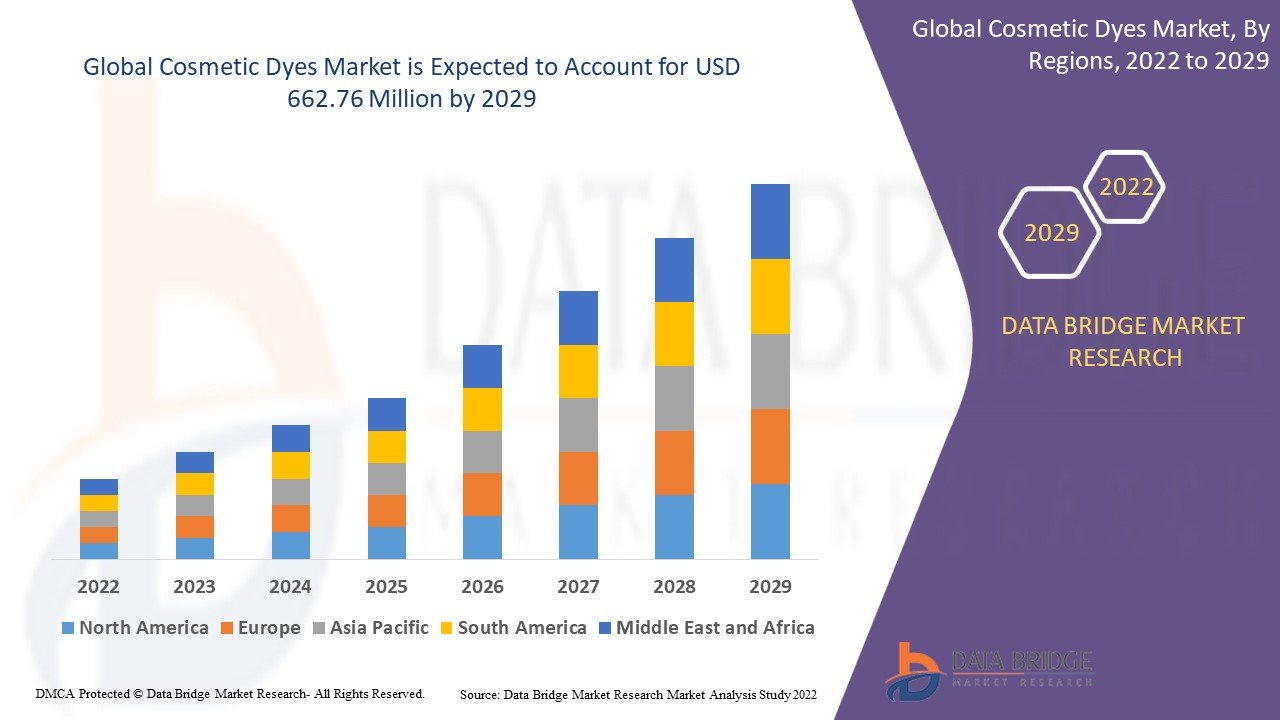The cosmetic industry thrives on innovation, and one of its most colorful aspects is the use of cosmetic dyes. These dyes play a crucial role in enhancing the visual appeal of beauty products, from lipsticks and eyeshadows to hair dyes and nail polishes. As consumer preferences shift toward personalized and vibrant beauty solutions, the demand for high-quality, safe, and sustainable cosmetic dyes is skyrocketing.
Cosmetic dyes are specially formulated colorants that comply with strict regulatory standards to ensure safety for skin and hair application. With the rise of social media and influencer culture, aesthetics have become a driving force behind purchasing decisions, further fueling the growth of this market. This guest post delves into the current landscape of the cosmetic dyes market, examining its size, share, opportunities, challenges, demand, and emerging trends.
Global cosmetic dyes market size was valued at USD 514.37 million in 2024 and is projected to reach USD 771.61 million by 2032, with a CAGR of 5.20% during the forecast period of 2025 to 2032.
Find out what’s next for the Cosmetic Dyes Market with exclusive insights and opportunities. Download full report:
https://www.databridgemarketresearch.com/reports/global-cosmetic-dyes-market
Market Size: A Spectrum of Expansion
The global cosmetic dyes market has witnessed significant growth in recent years. Valued at approximately $500 million in 2023, the market is projected to grow at a CAGR of 6-8% over the next decade, reaching $800 million to $1 billion by 2033. This expansion is fueled by several factors:
-
Rising Beauty Consciousness: Consumers are increasingly experimenting with bold and unconventional makeup looks, driving demand for vibrant and long-lasting dyes.
-
Growth of the Cosmetics Industry: The global cosmetics market continues to expand, with increasing spending on personal care products in emerging economies.
-
Innovation in Product Formulations: Brands are introducing advanced dye technologies, such as photochromic and thermochromic dyes, which change color based on external stimuli.
Asia-Pacific dominates the market due to high demand in countries like China, Japan, and South Korea, where K-beauty trends influence global cosmetics. North America and Europe follow closely, with a strong preference for organic and natural dyes.
Market Share: Key Players and Competitive Landscape
The cosmetic dyes market is highly competitive, with key players focusing on innovation, sustainability, and regulatory compliance. Some of the leading companies include:
-
BASF SE
-
Clariant AG
-
Sensient Technologies Corporation
-
Neelikon Food Dyes & Chemicals Ltd.
-
Chromatech Incorporated
These companies invest heavily in R&D to develop eco-friendly and non-toxic dyes, catering to the growing demand for clean beauty products. Synthetic dyes currently hold the largest market share due to their cost-effectiveness and wide color range. However, natural dyes are gaining traction, driven by consumer preference for organic and vegan cosmetics.
Market Opportunities: Coloring the Future
The cosmetic dyes market presents several lucrative opportunities for manufacturers and brands:
1. Rising Demand for Natural and Organic Dyes
Consumers are increasingly wary of synthetic chemicals, leading to a surge in demand for plant-based and mineral dyes. Brands that invest in bio-based colorants (such as beetroot extract, turmeric, and spirulina) can tap into the clean beauty movement.
2. Expansion in Men’s Grooming Products
The male grooming industry is booming, with products like hair dyes, beard tints, and skincare formulations incorporating cosmetic dyes. This segment offers significant growth potential.
3. Technological Advancements
Innovations such as water-soluble dyes, nano-pigments, and smart color-changing cosmetics are opening new avenues for product differentiation.
4. Emerging Markets
Countries in Latin America, the Middle East, and Africa are witnessing increased disposable income and beauty awareness, presenting untapped opportunities for cosmetic dye manufacturers.
Market Challenges: Navigating the Complexities
Despite its growth, the cosmetic dyes market faces several challenges:
1. Stringent Regulatory Standards
Regulatory bodies like the FDA (U.S.), EU Cosmetics Regulation, and China’s NMPA impose strict guidelines on dye safety. Compliance with these regulations can be costly and time-consuming.
2. High Cost of Natural Dyes
While natural dyes are in demand, their higher production costs compared to synthetic alternatives can limit widespread adoption.
3. Allergenic Concerns
Some synthetic dyes (e.g., certain azo dyes) have been linked to skin allergies, pushing brands to find safer alternatives without compromising on vibrancy.
4. Sustainability Pressures
Environmental concerns over dye production waste and microplastic pollution are pushing companies to adopt greener manufacturing processes.
Market Demand: What Consumers Want
Consumer preferences are shaping the demand for cosmetic dyes in several ways:
-
Long-Lasting & Vibrant Colors: Consumers seek dyes that retain their intensity without fading quickly.
-
Clean & Safe Formulations: There is a growing preference for paraben-free, cruelty-free, and non-GMO dyes.
-
Customization & Personalization: Brands offering bespoke color-matching solutions (e.g., foundation shades, personalized lipsticks) are gaining popularity.
-
Ethical Sourcing: Transparency in sourcing and production is becoming a key purchasing factor.
Market Trends: The Future of Cosmetic Dyes
Several trends are reshaping the cosmetic dyes industry:
1. Shift Toward Sustainable Dyes
Brands are adopting biodegradable and plant-derived dyes to meet eco-conscious consumer demands.
2. Digital Color Matching & AI Integration
AI-powered tools allow consumers to virtually try on makeup shades, increasing demand for precise dye formulations.
3. Rise of Multifunctional Dyes
Dyes with added benefits (e.g., UV protection, moisturizing properties) are gaining traction.
4. Growth of Temporary & Semi-Permanent Dyes
Products like peel-off lip tints and washable hair colors are trending, especially among younger consumers.
Conclusion
The cosmetic dyes market is evolving rapidly, driven by consumer demand for vibrant, safe, and sustainable color solutions. While challenges like regulatory hurdles and high production costs persist, opportunities in natural dyes, men’s grooming, and smart cosmetics offer immense growth potential. As brands innovate to meet these demands, the future of cosmetic dyes looks brighter—and more colorful—than ever.
Contact Us:
Data Bridge Market Research
US: +1 614 591 3140
UK: +44 845 154 9652
APAC : +653 1251 975
Email:- corporatesales@databridgemarketresearch.com

